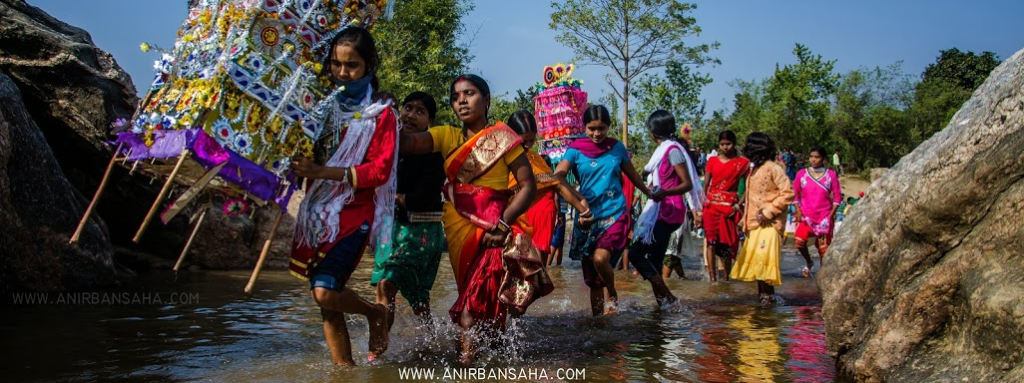(বাংলায় পড়ার জন্য এখানে ক্লিক করে।) (इसे हिंदी में पढ़ने के लिए यहां क्लिक करें)
The Tusu festival ( also known as Tusu Parab or Tusu Parob or Tusu Puja ) is a tribal festival in rural Bengal. It is celebrated in districts of Purulia, Bankura and Midnapur. The key features of the entire one month of celebrations are the Tusu songs which are folk music, the food and the fair. It ends on Makar Sankranti, with the immersion of Tusu structures. I witnessed the last day in Deulighata, Purulia. I was accompanying Averi for her paper. It is a pleasure having her write for my blog.
Getting out of the folds of ‘patisapta’, 2014 had ushered in the most unconventional Poush Sankranti I had ever spent in my life. In the company of two young, enthusiastic photographers, I was all excitement and anticipation as we headed for Deulghata, the site of Tusu bhasan, on the cold, cloudy, wintry morning of January 14th. I must confess that I had ignorantly travelled to Purulia with the intention of witnessing some of the rituals of the month-long Tusu puja. It was disappointing to know that Makar Sankranti marks the culmination of the festivities with the immersion of the Tusu choudala in the river Konsaboti. Even more frustrating was the knowledge that the tradition of worshipping Tusu through out the month of Poush has become obsolete! Perhaps there is no way how we can balance modernization with tradition. One has to make way for the other.
However, there was adequate recompense. The Tusu bhasan was a spectacle to behold. All that one can think of while remembering the bhasan is colours. The brightly decorated choudalas, the gorgeously dressed ladies, the dandy spectators—all added that dash of colour to the festivities which brightened up even the coldest and the cloudiest day of the season. The choudalas are wooden and bamboo frames decorated with colour papers, dolls and other artifices and considered an embodiment of the deity. It is a women’s festival and the choudalas are made at homes by chaste virgins (need to know how that is ascertained) or alternately sold at the local hats or markets. After the ‘punya snan’ or the holy bath in the morning, women and girls proceed in groups towards the river with the Tusu and singing Tusu songs. By noon, the riverbank is thronged with Tusunis (the girl/ woman who carries the Tusu), the gazers, the food peddlars, the stalls selling various wares, microphones blaring Tusu gaan and the urban photographers jostling for that perfect frame. As the girls splash through calf-deep waters, the boys, cheer, jeer and leer too, but mind you, its devoid of any malign intention, merely responding to the primary forces of life. I was told, however, that situations sometimes tend to get chaotic and out of hand. Variously worshipped as daughter, friend, confidante (sokhi), Tusu is more a member of the household, a domestic figure than a deity. Legend has it that Tusu or Tusumani sacrificed her life for love, be it for her husband or love for her people. Hence, as ladies immerse the Tusu, they pray for loving husbands and lasting fidelity. This provide the young men with occassion to present themselves as prospective eligible suitors and thus the festival turns to one of match-making and mirth, the boys spotting and teasing girls that may end in a fight or a witty repartee. Tusu is also a harvest festival marked with all the usual associations of fertility. It is a major festival among the tribes inhabiting the lower regions of the Chhota Nagpur Plateau and widely celebrated in Purulia , Birbhum and Bankura districts in West Bengal; in Ranchi in Jharkhand and in Mayurbhanj and Keonjhar districts in Odisha.
As the day drew to an end with fewer and fewer immersions around 3pm in the afternoon, young boys and girls could still be seen lingering on, picnic parties winding up, folk returning to their villages and the umbra of holiday fading into the penumbra of life and business. With two more days to go for the full moon, the ‘orbed maiden’ was already shining bright in a by-now-clear sky and I breathed a silent promise to revisit the land of Tusu , this time to welcome her on Agrahayan Sankranti.
Souvik Chatterjee shared with us one of the folksong,
“Ja Ja Tusu Ja Ja Lo
Dekha Gechhe Tor Pirit Lo
Tor Pirite Mon Maane Na
Boli Tor Pirite Agun Jole Na…”Translated : “Go Tusu go, We have seen your love, my heart is not convinced by your love, no fire is ignited by your love”.
Professor, Department of English, Sushil Kar College, Calcutta University.
Has an interest in the Folk culture of Bengal.
It is my privilege to have helped her visit Tusu Parab and provide her with assistance and photographs. Looking forward to more work with her.
